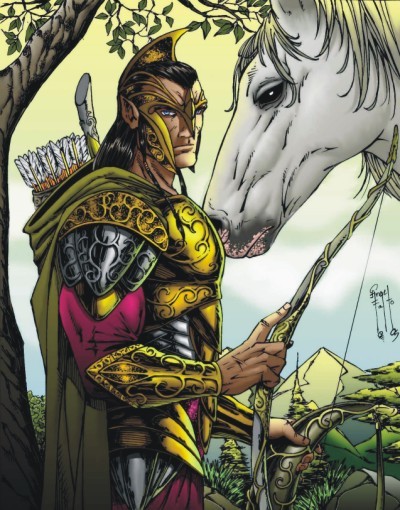Home Life
"Live and Learn."
"Make good"
Gift Giving
If Aulë comes to visit you, you will certainly receive a gift from him. When you visit him, it is good manners to bring a gift of your own, preferably something you had some hand in the making. Edibles that can be shared are always appropriate. If you give Aulë a gift, he will give you one also.
Weaponry
"Make armory with a heavy heart: regret what those creations will cause."A Vala cannot reasonably expect others to sanctify his symbols utterly to peaceful purposes in a dangerous world. Those who worshipfully use a hammer in battle receive a hesitant blessing. Those who seek a non-destructive end to battle receive a joyous blessing.
"I do not teach others to make the most destructive devices invented: there is no merciful cause for their use."
The hammer shape of "T" resembles the second tengwar letter of the name "Aulë" (the "L") .
Battle
Ever
since Eru Ilúvatar prevented his deadly hammer from slaying newly forged
dwarves, Aulë uses the hammer against no living thing. Further, he
shuns deadly violence to ANY thinking creature since The One allowed
such mercy to his dwarves. Aulë considers the living creations of The
One and Yavanna superior to his attempt in this area, but he is still
proud of his Dwarves.
Aulë
will not violently battle in the presence of elves. Even his physical
attacks and defenses damage nearby elves too easily. Even chanting phrases of the Ainulindalë that form every part of existence can create a profound magical effects. Since some elves are terrified and dismayed by the powers wielded, Aulë is cautious about invocations. Thus, in active conflict, he may help arm his allies, but absents himself or takes takes the role of healer. He will help clean up and repair the battle-space.
Others naturally must be free to act as predator and executioner. Aulë's nearest kin are among the fiercest combatants in all creation. That is how The One made them.
Aulë's preferred tactics:
- Inventive, non-destructive solutions
- Enchant sleep
- Restrain with cages, webs, chains, or earth.
- Find where then enemy belongs and get them there.
- Arm then heal allies already present and engaged.
- If all foes are mindless, throw boulders.
- Bring Oromë or Tulkas there
Education
Aulë will attempt to teach anything to anyone who asks. He prefers to refer a question to an existing reference or an advanced student: it teaches the questioner how to research (a most basic study skill) or solidifies the advanced student's knowledge by codifying it for another.
Without skill and practice, talent cannot express. Skill can be taught: Talent cannot. One can be skilled without much talent yet be productive in any craft. Not all have the ear, voice or will for music, chanting, or magic. Not all have the eye, mind or strength for stone, metal, earth and wood work; nor have all the touch, heart, or artistry for writing, drafting and design, yet anyone can do these things with some success.
"Gain skill. Talent may follow."
Incognito in Last Ages
Criticize
another's work only on invitation. It's better to ask what the student
finds improvable in his own work, then agree with guidance or disagree
with examples. It's bad form to criticize a beginner for failing to
create a master-work. Offering
a work up for sale is an invitation to criticism. Selling instead of gifting or donation is also a
reasonable act: it's good for the soul that the receiver give something
in exchange for work for able hands.
"Eggs cannot harmonize."
Damaging
a student or letting a student damage himself is an abomination, no
matter what the provocation, circumstance or device. When a student is a
likely danger to himself or others, touch or restrain him to get his
full attention. Only in safety and respect can correction and
instruction occur.
Incognito in Last Ages
In later ages, long after the events of the Lord of the Rings, Aulë travels as an humble itinerant tinker "from a large and diverse family from Almaren" crafting, repairing, selling and gifting doodads, gadgets, and knickknacks using one of his many names. (( This is merely to open up role playing possibilities, since he likely stayed in Aman til the wide world ends)) He will teach crafts should students and need appear. ((If we role play this, Aule will really teach you something of Second Life content creation as the scene warrants.))
He'll stay a while, set things better, then move on. Repeat for many, many years. As this kind, magical, and generous fellow gains a fondness of mortals, he may become a mysterious yet legendary jolly old elf of fable, considered a saint even. We'll see how that plays.




